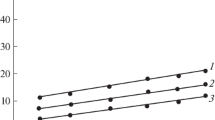Abstract
A single cladding track with good surface is the premise of preparation of a good coating in plasma cladding process. Generally, the available domain for the match of factors (ADMF) is not clear for a specific set-up system. The ADMF of principle operational factors (current of the transferred arc P, powder feeding rate F, and scanning speed S) was primarily detected by a discriminant model of mahalanobis distance. To predict and control the geometric features (height, width, and surface finish) of a single plasma cladding track, Uniform design and stepwise regression analysis were applied to build statistic models. These statistic models were confirmed by experiments. A coating with designed size was prepared based on the statistic models.













Similar content being viewed by others
References
J. Wilden, J.P. Bergmann, and H. Frank, Plasma Transferred Arc Welding—Modeling and Experimental Optimization, J. Therm. Spray Technol., 2006, 15(4), p 779-784
T. Wiederkehr and H. Müller, Acquisition and Optimization of Three-Dimensional Spray Footprint Profiles for Coating Simulations, J. Therm. Spray Technol., 2013, 22(6), p 1044-1052
T. Wiederkehr, B. Klusemann, H. Müller, and B. Svendsen, Fast, Curvature-Based Prediction of Rolling Forces for Porous Media Based on a Series of Detailed Simulations, Adv. Eng. Softw., 2011, 42(4), p 142-150
S.M. Aithal, V.V. Subramaniam, J. Pagan, and R.W. Richardson, Numerical Model of a Transferred Plasma Arc, J. Appl. Phys., 1998, 84(7), p 3506-3517
F. Kong, H. Zhang, and G. Wang, Numerical Simulation of the Transient Multiphase Field During Plasma Deposition Manufacturing Composite Materials, Sci. China Ser. G, 2009, 52(4), p 508-517
V. Balasubramanian, A.K. Lakshminarayanan, R. Varahamoorthy, and S. Babu, Application of Response Surface Methodolody to Prediction of Dilution in Plasma Transferred Arc Hardfacing of Stainless Steel on Carbon Steel, J. Iron Steel Res. Int., 2009, 16(1), p 44-53
N. Srimath and N. Murugan, Development of Mathematical Models for Prediction of Weld Bead Geometry in Cladding Mild Steel Valve Seat Rings by PTAW, Proc. Eng., 2012, 38, p 15-20
A. Mozaffari, A. Fathi, A. Khajepour, and E. Toyserkani, Optimal Design of Laser Solid Freeform Fabrication System and Real-Time Prediction of Melt Pool Geometry Using Intelligent Evolutionary Algorithms, Appl. Soft Comput., 2013, 13(3), p 1505-1519
J. Paulo Davim, C. Oliveira, and A. Cardoso, Predicting the Geometric form of Clad in Laser Cladding by Powder Using Multiple Regression Analysis (MRA), Mater. Des., 2008, 29(2), p 554-557
Y. Sun and M. Hao, Statistical Analysis and Optimization of Process Parameters in Ti6Al4V Laser Cladding Using Nd:YAG Laser, Opt. Laser Eng., 2012, 50(7), p 985-995
K.-T. Fang and L.-Y. Chan, Uniform Design and Its Industrial Applications, The Springer Handbook of Engineering Statistics, H. Pham Ed., Springer, Berlin, 2006, p 229-245
J. Mazumder, D. Dutta, N. Kikuchi, and A. Ghosh, Closed Loop Direct Metal Deposition: Art to Part, Opt. Laser Eng., 2000, 34(4-6), p 397-414
P.C. Mahalanobis, On the generalised distance in statistics, Proceedings of the National Institute of Sciences of India, 1936, p 49-55
H. Qi, M. Azer, and P. Singh, Adaptive Toolpath Deposition Method for Laser Net Shape Manufacturing and Repair of Turbine Compressor Airfoils, Int. J. Adv. Manuf. Technol., 2010, 48(1-4), p 121-131
U. de Oliveira, V. Ocelík, and J.T.M. De Hosson, Analysis of Coaxial Laser Cladding Processing Conditions, Surf. Coat Technol., 2005, 197(2-3), p 127-136
Acknowledgments
The authors would like to thank the financial support for this work from the Research Foundation of Education Bureau of Hubei Province, China (Q20131804), the Foundation of Province Key Laboratory for Modern Auto Parts Technology in Hubei, China (201201), and the Foundation of Hubei University of Automotive Technology, China (BK201206). We give particular thanks to Jennifer Tribble, who is from Rose-Hulman Institute of Technology, Terre Haute, Indiana, USA, for her refining the grammar of our manuscript.
Author information
Authors and Affiliations
Corresponding author
Appendix
Appendix
Rights and permissions
About this article
Cite this article
Liu, J., Zeng, D. & Xing, J. Statistic Modeling and Optimization of the Track in Plasma Cladding Process. J Therm Spray Tech 23, 1390–1403 (2014). https://doi.org/10.1007/s11666-014-0140-z
Received:
Revised:
Published:
Issue Date:
DOI: https://doi.org/10.1007/s11666-014-0140-z



